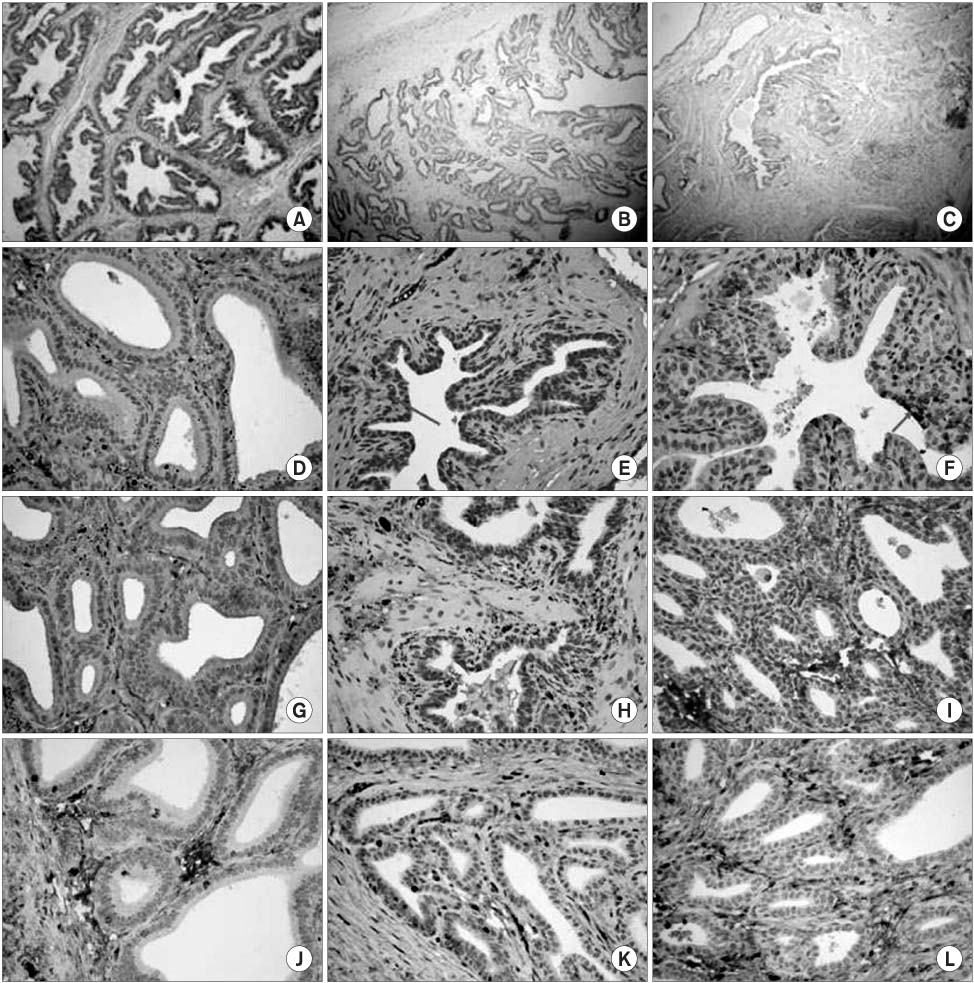Korean J Urol.
2006 Feb;47(2):201-205. 10.4111/kju.2006.47.2.201.
Expression Pattern of Neuroendocrine Cells and Survivin in the Prostate of Rabbits
- Affiliations
-
- 1Department of Urology, Soonchunhyang University College of Medicine, Bucheon, Korea. Beetho@schch.co.kr
- 2Department of Pathology, Soonchunhyang University College of Medicine, Bucheon, Korea.
- KMID: 2294202
- DOI: http://doi.org/10.4111/kju.2006.47.2.201
Abstract
-
PURPOSE: The neuroendocrine cell (NE cell) is thought to play an important role in the development of hormone-refractory prostate cancer. Survivin is one of the IAPs (inhibitors of apoptosis), and it is expressed in the NE cell and in most of the common cancers, but not in normal tissue. The objective of this study was to investigate the expression pattern of the NE cell and survivin in the prostate of rabbits.
MATERIALS AND METHODS
The 9 rabbits underwent orchiectomy and their prostates were removed at 0 weeks (control), 2 weeks and 6 weeks after orchiectomy. Each of the prostatic tissue specimens was stained with H&E; immunohistochemical staining was done for chromogranin A, synaptophysin and survivin, and the tissue specimens were then examined by microscopy.
RESULTS
In the prostate of rabbits, most of the NE cells were located between the epithelial gland and the stroma. NE differentiation occurred 6 weeks after orchiectomy. The location of cells that were positive for survivin was almost same as that of the NE cells.
CONCLUSIONS
The main location of NE cells in the prostate of rabbits was between the epithelial gland and the stroma, and NE differentiation occurred 6 weeks after orchiectomy, the same as in a human or a dog. The location of survivin positive cells coincided with that of the NE cells. Therefore, a rabbit seems to be a suitable animal model for the study of the NE cell.
Keyword
MeSH Terms
Figure
Cited by 1 articles
-
Expression of Survivin and Bcl-2 in Benign Prostatic Hyperplasia Treated with a 5-alpha-reductase Inhibitor
Woo Heon Cha, Tae Jung Jang, Kyung Seop Lee
Korean J Urol. 2008;49(3):242-247. doi: 10.4111/kju.2008.49.3.242.
Reference
-
1. Aprikian AG, Cordon-Cardo C, Fair WR, Reuter VE. Charac terization of neuroendocrine differentiation in human benign prostate and prostatic adenocarcinoma. Cancer. 1993. 71:3952–3965.2. Abrahamsson PA. Neuroendocrine differentiation in prostatic carcinoma. Prostate. 1999. 39:135–148.3. Angelsen A, Mecsei R, Sandvik AK, Waldum HL. Neuroendocrine cells in the prostate of the rat, guinea pig, cat, and dog. Prostate. 1997. 33:18–25.4. Xing N, Qian J, Bostwick D, Bergstralh E, Young CY. Neuroendocrine cells in human prostate over-express the anti-apoptosis protein survivin. Prostate. 2001. 48:7–15.5. Helpap B. Morphology and therapeutic strategies for neuroendocrine tumors of the genitourinary tract. Cancer. 2002. 95:1415–1420.6. Xue Y, Verhofstad A, Lange W, Smedts F, Debruyne F, de la Rosette J, et al. Prostatic neuroendocrine cells have a unique keratin expression pattern and do not express Bcl-2: cell kinetic features of neuroendocrine cells in the human prostate. Am J Pathol. 1997. 151:1759–1765.7. Bonkhoff H. Neuroendocrine cells in benign and malignant prostate tissue: morphogenesis, proliferation, and androgen receptor status. Prostate. 1998. 8:Suppl. 18–22.8. Bonkhoff H, Stein U, Remberger K. Endocrine-paracrine cell types in the prostate and prostatic adenocarcinoma are postmitotic cells. Hum Pathol. 1995. 26:167–170.9. Cohen RJ, Glezerson G, Taylor LF, Grundle HA, Naude JH. The neuroendocrine cell population of the human prostate gland. J Urol. 1993. 150:365–368.10. Ismail A HR, Landry F, Aprikian AG, Chevalier S. Androgen ablation promotes neuroendocrine cell differentiation in dog and human prostate. Prostate. 2002. 51:117–125.11. di Sant'Agnese PA. Neuroendocrine differentiation in human prostatic carcinoma. Hum Pathol. 1992. 23:287–296.12. Aprikian AG, Cordon-Cardo C, Fair WR, Reuter VE. Characterization of neuroendocrine differentiation in human benign prostate and prostatic adenocarcinoma. Cancer. 1993. 71:3952–3965.13. Yamamoto T, Tanigawa N. The role of survivin as a new target of diagnosis and treatment in human cancer. Med Electron Microsc. 2001. 34:207–212.
- Full Text Links
- Actions
-
Cited
- CITED
-
- Close
- Share
- Similar articles
-
- Expression of Survivin Correlated with Antiapoptosis in Benign Prostate Hyperplasia and Prostate Cancer
- The Prognostic Significance of Neuroendocrine Differentiation for Treating Prostatic Carcinoma in 699 Cases of Radical Prostatectomy
- Expression of Survivin and Bcl-2 in Benign Prostatic Hyperplasia Treated with a 5-alpha-reductase Inhibitor
- Change in Expression of Survivin Caused by Using Oxaliplatin in HCT116 Colon Cancer Cells
- Expression of Neuroendocrine Cells in the Prostate of Rat and Guinea Pig after Orchiectomy


